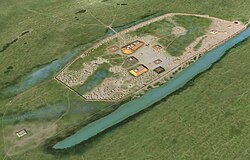Mississippian culture
Mississippian culture is the culture of the Mississippian people. They were Native Americans who lived in the Mississippi River Valley. Around 900–1450 AD, the Mississippian culture developed and spread through the Eastern Woodlands.[1] Mississippian people were most often farmers who settled into river valleys and grew the "three sisters" of corn, beans and squash.[2]
The Mississippian peoples lived throughout the Southeast and Midwest, an area from the Florida panhandle westward into Oklahoma, northward to Minnesota and eastward to Ohio.[3]
Mississippian Culture Media
A human sacrifice of fifty-three Native American women at Cahokia
Shell tempered ceramic effigy jug with swirls painted in clay slip, Rose Mound, Cross County, Arkansas, U.S., 1400–1600, 8" (20 cm) high
Replica of a Mississippian house from over 1000 years ago excavated at the Aztalan site of the Oneota region in an exhibit at the Wisconsin Historical Museum
Cahokia, the largest Mississippian culture site
Kincaid, showing its platform mounds and encircling palisade
References
- ↑ King, Adam. "Mississippian period: overview." New Georgia Encyclopedia. http://www.georgiaencyclopedia.org/articles/history-archaeology/mississippian-period-overview
- ↑ Hirst, Chris. Mississippian culture - moundbuilder-horticulturalists of North America. http://archaeology.about.com/od/mississippiancivilization/qt/mississippian.htm Archived 2014-07-11 at the Wayback Machine
- ↑ Seppa, Nathan. 1997. Metropolitan life on the Mississippi. The Washington Post. https://www.washingtonpost.com/wp-srv/national/daily/march/12/cahokia.htm







